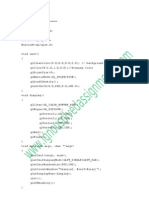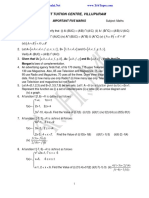0 ratings0% found this document useful (0 votes)
148 views34 pagesMCS-021 (2023-24) Solved Assignment
3rd sem solved assignment
Uploaded by
amisatyam0Copyright
© © All Rights Reserved
We take content rights seriously. If you suspect this is your content, claim it here.
Available Formats
Download as PDF or read online on Scribd
0 ratings0% found this document useful (0 votes)
148 views34 pagesMCS-021 (2023-24) Solved Assignment
3rd sem solved assignment
Uploaded by
amisatyam0Copyright
© © All Rights Reserved
We take content rights seriously. If you suspect this is your content, claim it here.
Available Formats
Download as PDF or read online on Scribd
You are on page 1/ 34
Course Code : MCS-021
Course Title
Assignment Number
Data and File Structures
BCA(IID/021/Assignment/2023-24
Maximum Marks 100
Weightage 30%
Last Dates for Submission : 31 October, 2023 (For July Session)
: 30" April, 2024 (For January Session)
This assignment has 10 questions of 8 Marks each, answer all questions. Rest 20 marks are
for viva voce. You may use illustrations and diagrams to enhance the explanations. Please
go through the guidelines regarding assignments given in the Programme Guide for the
format of presentation.
au.
2.
Q@.
Qs.
Quo.
Elaborate various asymptotic notations used to evaluate the efficiency of th
(8)
Write a program that accepts two polynomials as input and displays the resultant polynomial after
multiplication of input polynomials 8)
Write a C programme to implement a doubly linked list. Also write functions to perform insertion
and deletion operations in it 8)
What is a Circular Queue? Write an algorithm to perform insertion and deletion operation in a
Circular Queue 8)
Write a program in C for insertion sort. Write the step-by-step working of the insertion sort for the
following set of data: 10, 25, 86, 1, 16, 95, 37, 56, 5, 15, 20, 4. Also count the number of swaps and
comparison operations performed for it 8)
Write a detailed note on file organization techniques. 8)
Create the binary tree for which the in-order and post order traversal are given as below: @)
In-order: QUVTMPSYZXR.
Post-order: VUTQZYXSRPM
Create a B tree of order-S for the following keys, inserted in the sequence. @)
25,5, 10, 2, 3.35,
10, 50, 55, 60, 12, 18, 20, 1
Further, delete the keys 1, 2, 10, and 12. Show all the intermediate steps.
Create AVL tree for the following keys inserted in the order: 8)
5,15, 3,25, 10, 2, 35, 7, 45, 30, 12, 20, 14
7, and 8. Show all the intermedia
Further, delete the keys 2,
steps.
Solve the following instance of single source shortest paths problem with vertex‘ as the source
using suitable method. 8)
Copyright with Kunj Publication only Not for resale
Course Code: MCS-021
Course Title: Data and File Structures
Assignment Number: BCA (III)/021/Assignment/2023-24
DisclaimertSpecil Nore: These ae jut he somple of the AnswerfSolations 0 some ofthe Questions given in the Assignments. These
Sample Answerolutns are prepared by Private TeacherTusor urs forthe help an uldanceof he suden to get am ideo howe
Ifthe can anever the Questions sven the Asignents We donot lain 10% accuracy of these sample anewer as these are based on he
nol aa capability of Private TeacherTuto. Sample ansiers may be sen asthe Guldeep forthe tference to prepare the
‘ancwers ofthe question given in the assignment As thee solutions and answers are prepared bythe private TeacherTwor so he chances
‘fervor or mistake cannot be denied. Any Omission or Ervor is highly regretied though every care hasbeen hen whe preparbg these
‘Sample Answer Solutions Please conul our own Teacher/Tuor before you prepare apartictar Answer av for up-to-date and ext
!nformason, data and soluhon.Staden should mus ea and refer the fica tay. material proved by the univer
This assignment has 10 questions of 8 Marks each, answer all questions. Rest 20
marks are for viva voce. You may use illustrations and diagrams to enhance the
explanations. Please go through the guidelines regarding assignments given in the
Programme Guide for the format of presentation.
QI. Elaborate various asymptoti@ notations) used to evaluate the efficiency of thi
algorithm,
Asymptotic notations are mathematical tools used to analyze and compare the
efficiency of algorithms in computer science. They help us understand how the
algotithin’speFforinance grows With the input size, giving usan ide of how it Will
behave for large inputs. The three most commonly used asymptotic notations are:
1, Big O Notation (O-notation)
Big O notation describes the upper bound or worst-case scenario of an algorithm's
time complexity. It provides an upper limit on the growth rate of the algorithm's
running time Concerning the input size. In other words, it gives an approximation of
how the algorithm's performance scales with the worst possible input.
Mathematically, for a function f(n), we say f{(n) is O(g(n)) if there exist positive
constants C and n0 such that 0 < fin) < C * g(n) for all n> nO. In simple terms, fn) is
bounded by the function g(n) up to a constant factor for sufficiently large values of n.
For example, if an algorithm has a time complexity of O(n42), it means the
algorithm’s running time grows quadratically with the input size n.
2. Omega Notation (Q-notation):
Omega notation describes the lower bound or best-case scenario of an algorithm's
time complexity. It provides a lower limit on the growth rate of the algorithm's
running time concerning the input size. In other words, it gives an approximation of
how the algorithm's performance scales with the best possible input.
Copyright with Kunj Publication only Not for resale
Mathematically, for a function f{(n), we say f{n) is Q(g(n)) if there exist positive
constants C and n0 such that 0 < C * g(n) < f(n) for all n> n0. In simple terms, f(n) is,
bounded from below by the function g(n) up to a constant factor for sufficiently large
values of n,
For example, if an algorithm has a time complexity of O(n), it means the algorithm's
running time grows linearly with the input size n in the best-case scenario.
3. Theta Notation (@-notation):
‘Theta notation provides a tight bound on an algorithm's time complexity, capturing
both the upper and lower bounds. It gives a range within which the algorithm's
performance will fall concerning the input size.
Mathematically, for a function f{(n), we say f{n) is @(g(n)) if there exist positive
constants C1, C2, and n0 such that 0.>Ghr* g(n) < f{n) < C2 * g(n) for all n> n0. In
simple terms, f(n) is bounded’ both from above and below by the function g(n) up to
constant factors for sufficiently large values of n.
For example, ifan algorithm has a time complexity of @(n), it means the algorithm's
running time grows linearly with the input size n in both the best and worst-case
scenarios,
In summary, these asymptotic notations help us analyze find compare the efficiency of
algorithms based on how their running times grow as the input size increases. They
allow Us to make informed decisions when Choosing the most appropriate algorithm
fora specific problem.
Q2. Write a program thal accepts two polynomials as input and displays the
resultant polynomial after multiplication of input polynomials.
Python program that multiplies two polynomials and displays the resultant
polynomial. We will represent polynomials as lists of coefficients, where the index of
the list corresponds to the power of the variable. For example, the polynomial 3x*2 +
2x + 1 will be represented as [3, 2, 1].
Here's the Python program:
def multiply_polynomials(poly 1, poly2):
result_degree = len(poly |) + len(poly2) - 2 # Degree of the resultant polynomial
# Initialize the result list with zeros
result_poly = [0] * (result_degree + 1)
# Perform multiplication of the two polynomials
for iin range(len(poly1)):
for j in range(len(poly2)):
result_poly(i + j] += poly![i] * poly2{j]
return result_poly
def display_polynomial(poly):
degree = len(poly) - 1
"CR PUBLICATION
elif degree -i== 1: ALL US:-
polynomial_str
polynomial_str += str(coefficient)
if i < degree:
polynomial_str +
print(polynomial_str)
if _name__ == "__main_":
# Input polynomials as lists of coefficients (highest power to lowest power)
Copyright with Kunj Publication only Not for resale F”
poly! = list(map(int, input("Enter the coefficients of the first polynomial (separated
by space): ").split))
poly2 = list(map(int, input("Enter the coefficients of the second polynomial
(separated by space): ").split()))
+# Multiply the input polynomials
result = multiply_polynomials(poly1, poly2)
# Display the resultant polynomial
print("Resultant polynomial after multiplication:
display_polynomial(result)
You can run this program and enter the coefficients of the two polynomials when
prompted. The program will then multiply the two polynomials and display the
RUNPBB:
deletion operations:
#include
struct Node {
int data;
struct Node* prev;
struct Node* next;
bk
/ Function to create a new node
struct Node* createNode(int data) {
Copyright with Kunj Publication only Not for resale Ph.
struct Node* newNode = (struct Node*)malloc(sizeof(struct Node));
if (newNode == NULL) {
printf("Memory allocation failed!\n");
exit(1);
}
newNode->data = data;
newNode->prev = NULL;
newNode->next = NULL;
return newNode;
void insertAtBeginning( struct Node** head, int
CONFPUBLICATION
(Phead)->prev = newNode; ALL US:- vy -
// Function to insert a new node at the end of the list
void insertAtEnd (struct Node** head, int data) {
struct Node* newNode = createNode(data);
if (*head == NULL) {
*head = newNode;
} else {
struct Node* temp = “head;
while (temp->next != NULL) (
Copyright with Kunj Publication only Not for resale Ps...
temp = temp->next;
}
temp->next = newNode;
newNode->prev = temp;
// Function to delete a node from the list
void deleteNode(struct Node** head, int key) {
if (*head == NULL) {
printf("List is empty!\n");
PUBLIGAD ui
p laa ALL US:- ‘
return;
if (temp == NULL) {
printf("Node with data %d not found!\n", key);
return;
if (temp->prev != NULL) {
temp->prev->next = temp->next:
} else {
*head = temp->next;
Copyright with Kunj Publication only Not for resale
if (temp->next != NULL) {
temp->next->prev = temp->prev;
free(temp);
// Function to display the doubly linked list
void display(struct Node* head) {
struct Node* temp = head;
KONE PUBLICATION
rintf(\n"); ALL US:- = a
// Function to free the memory allocated for the list
void freeList(struct Node head) {
struct Node* temp;
while (head != NULL) {
temp = head;
head = head->next;
free(temp);
Copyright with Kunj Publication only Not for resale P.
int main) {
struct Node* head = NULL;
insertAtEnd(&head, 10);
insertAtBeginning(&head, 5);
insertAtEnd(&head, 20);
insertAtBeginning(&head, 2);
insert AtEnd(&head, 30);
display(head);
deleteNode(&heady'5);
deleteNode(&head, 30);
display head);
freeList(head);
return 0;
This C program creates a doubly linked list, provides functions to insert nodes at the
beginning and end of the list, delete nodes with a specific data value, and displays the
list before and after deletion operations. Note that the program also includes a function
to free the dynamically allocated memory used for the list.
Q4. What is a Circular Queue? Write an algorithm to perform insertion and
deletion operation in a Circular Queue
A Circular Queue is a data structure that represents a circular buffer, similar to a
regular queue, but with a fixed size. It uses an array to store elements, and when the
queue becomes full, it wraps around and starts reusing the empty slots from the
beginning of the array. This circular behavior allows for efficient memory utilization
and avoids shifting elements during insertions and deletions, unlike a regular linear
queue
Copyright with Kunj Publication only Not for resale PI
To implement a Circular Queue, you need to keep track of two pointers: "front" and
“rear.” The "front" pointer points to the first element in the queue, and the "rear"
pointer points to the last element. Initially, both pointers are set to -1. When the queue
is empty, "front" and "rear" both point to -1. For each insertion, the "reat" pointer is
incremented, and for each deletion, the "front" pointer is incremented.
Here's the algorithm to perform insertion and deletion operations in a Circular Queue:
1, Initialize the Circular Queue:
+ Set the maximum size of the Circular Queue (MAX_SIZE
+ Create an array of size MAX_SIZE to hold the elements.
+ Initialize front and rear pointers to -1
. Check if the Circular Queue is empty:
+ If front and rear both are -1, the queue is empty.
. Check if the Circular Queue is full:
+ If (reat +1) % MAX_SIZE == front, the queue is full.
. Insertion Operation (Enqueue):
« Cheek if the queue is full.
‘+ If it’s full, return an error of handle it accordingly.
+ Increment the rear pointer: rear = (rear +1) % MAX_SIZE.
+ Insert the element at the rear position: queue[rear) = element.
. Deletion Operation (Dequeue):
+. Checkiif the queue is empty.
Ifit's empty, return an error or handle it accordingly.
Get the element to be dequeued: dequeuedElement = queue[front]..
If front and rear are pointing to the same element (ie., there's only one
clement in the queue), reset both pointers to -1.
Otherwise, increment the front pointer: front = (front + 1) %
MAX _SIZE.
Return the dequeuedElement.
Here's a Python implementation of the Circular Queue:
class CircularQueue:
def __init__(self, max_size):
self.queue = [None] * self. MAX_SIZE.
self.front = self.rear = -1
def is_empty(self):
return self.front == -1 and self.rear =:
def is_full(self):
return (self.rear + 1) % self. MAX_SIZE,
def enqueue(self, element):
if self.is_full0:
KUK
def dequeue(self):
if self.is_empty():
print("Circular Queue is empty. Unable to dequeue.")
return None
dequeued_element = self.queue[self.front]
if self.front == self.rear:
self.front = self.rear = -1
else:
self-front = (self.front + 1) % self: MAX_SIZE
return dequeued_element
Publication only Not for resale
You can create an instance of the CircularQueue class, set the maximum size, and then
perform insertion (enqueue) and deletion (dequeue) operations on it.
QS. Write a program in C for insertion sort. Write the step-by-step working of
the insertion sort for the following set of data: 10, 25, 86, 1, 16, 95, 37, 56, 5, 15,
20, 4. Also count the number of swaps and comparison operations performed for
it.
C program for insertion sort, along with the step-by-step working and the count of,
swaps and comparisons for the given set of data.
include
11 Function to perform insertion sort
void insertionSort(int arr{}, int n, int “swaps, int *comparisons) {
inti, key, j
for (i = 1; i < nyi
il:
KUNJ PUBLICATION
/Move elements of arr{0..i-1] th Her than key to ane poston ahead of
it Current position
hile G@>=0 &&
ars + 1) = ari;
(swaps);
j=i-1
)
(*comparisons)++;
arr{j + 1] =key;
// Function to print the array
Copyright with Kunj Publication only Not for resale
void printArray(int arr[], int n) {
for (int i = 0; i 10)
Swaps: | (25 moves to the right of 10)
Array: 10, 25, 86, 1, 16, 95, 37, 56, 5, 15, 20, 4
Step 3: 2nd pass - Insertion of 86:
‘Comparisons: 1 (86 > 25)
Swaps: | (86 moves to the right of 25)
Array: 10, 25, 86, 1, 16, 95, 37, 56, 5, 15, 20, 4
Step 4: 3rd pass - Insertion of I:
Comparisons: 2 (1 < 86, L-<25)
Swaps: 2 (86 and 25.move to the right)
Array: 10, 25/86, 86, 16, 95, 37, 56, 5, 15, 20, 4
Step 5: 4th pass - Insertion of 16:
Comparisons: 2 (16 < 86, 16 > 25)
Swaps: 1 (86 moves to the right of 25)
Array: 10, 25, 25, 86, 16, 95, 3756, 5, 15, 20, 4
Step 62 Sth pass~ Insertion of 95:
Comparisons: 2 (95 > 86, 95 > 25)
Swaps: 0 (No swaps)
Array: 10, 25, 86, 95, 16, 95, 37, 56, 5, 15, 20, 4
Step 7: 6th pass - Insertion of 37:
Comparisons: 3 (37 < 95, 37 > 86, 37 > 25)
Swaps: 2 (95 and 86 move to the right)
Array: 10, 25, 37, 86, 95, 95, 37, 56, 5, 15, 20, 4
Step 8: 7th pass - Insertion of 56:
Comparisons: 3 (56 < 95, 56 > 86, 56 > 37)
Swaps: | (95 moves to the right of 37)
Copyright with Kunj Publication only Not for resale
Array: 10, 25, 37, 56, 86, 95, 37, 56, 5, 15, 20, 4
Step 9: 8th pass - Insertion of 5:
Comparisons: 4 (5 < 95, 5 < 86, 5 < 56,5 > 37)
Swaps: 3 (95, 86, and 56 move to the right)
Array: 10, 25, 37, 56, 86, 95, 95, 86, 56, 15, 20, 4
Step 10: 9th pass - Insertion of 15:
Comparisons: 4 (15 < 95, 15 < 86, 15 < 56, 15 > 37)
Swaps: 3 (95, 86, and 56 move to the right)
Array: 10, 25, 37, 56, 86, 86, 95, 56, 56, 15, 20, 4
Step 11: 10th pass - Insertion of 20:
Comparisons: 5 (20 < 95, 20 <,86720 < 56, 20 $56, 20 > 37)
Swaps: 4 (95, 86, 56, and'56 move to the right)
Array: 10, 25,37,56, 86, 86, 95, 95, 56, 56, 20, 4
Step 12: | Ith pass - Insertion of 4:
Comparisons: 6 (4 < 95, 4 < 86, 4 < 56,4 < 56,4 < 20, 4.< 56)
Swaps: 595, 86, 56, 56, and 20 move tothe right)
Atay: 10, 25, 37, 56, 86, 86, 95, 95, 56, 56,20, 4
‘The final sorted array is:/l, 4, 5, 10, 15, 16, 20, 25, 37, 56, 86, 95
Number of swaps: 21
Number of comparisons: 38
Q6. Write a detailed note on file organization techniques.
File organization techniques refer to the methods and structures used to store and
manage data within computer systems. These techniques are crucial for efficient data
retrieval, storage, and maintenance. Different file organization techniques are
employed depending on the specific requirements of the application, the type of data,
and the expected access patterns. Here are some of the common file organization
techniques:
1. Sequential File Organization: In a sequential file organization, data is stored
in a continuous sequence, one after another. Each record has a fixed length, and
records are accessed sequentially from the beginning to the end of the file. It is,
suitable for applications with frequent sequential access patterns, such as batch
Copyright with Kunj Publication only Not for resale.
processing systems. However, random access to records is inefficient, as the
system must scan through all preceding records to reach the desired one.
Advantages:
+ Simple and easy to implement.
+ Efficient for sequential processing and processing large volumes of data.
Disadvantages:
+ Inefficient for random access.
+ Insertions and deletions can be time-consuming.
2. Indexed Sequential File Organization: This technique combines aspects of
sequential and indexed file organization. The file contains a primary index that
stores key values and their corresponding disk addresses (pointers) to the actual
data records. The primary index:is:typically sorted, allowing for efficient
binary search to locate'the desired record's address. Once the address is found,
the system cam tise sequential access to retrieve the record itself.
Advantages:
+) Efficient for both sequential and random aecess’
+ Suitable for applications with varying access patterns.
Disadvantages:
+ Requires additional overhead to maintain the index.
+ Insettions and deletions may require index updates, potentially causing
performance issues.
Direct (Hash) File Organization: The direct file organization, also known as
hash file organization, uses a hash function to calculate the storage location of a
record based on its key value. The hash function generates an address for each
record, and data is stored at these calculated addresses. This technique allows
for quick access to records based on their keys.
Advantages:
+ Fast access for records with known keys.
+ Suitable for applications requiring quick data retrieval.
Disadvantages:
+ Can lead to collisions (different records getting the same address), which
requires handling through overflow areas or chaining.
+ Inefficient for range queries or sorting the records based on keys.
Copyright with Kunj Publication only Not for resale ~
4. Indexed File Organization: In indexed file organization, an index table is
maintained separately from the main data file. This table contains key values
and their corresponding disk addresses. The index table allows for efficient
lookup of record addresses, enabling quick access to desired records.
Advantages:
+ Efficient for random access and retrieval based on keys.
+ Changes in the main data file do not require frequent updates to the index table.
Disadvantage:
+ Requires extra storage space for the index table.
+ Insertions and deletions may require updates to the index, impacting
performance.
B-Tree and B+Tree File Organization: B-trees and B+trees are balanced tree
structures used for organizing large amounts of data. They are commonly
employed in database management systems and file systems. These trees
maintain data in a hierarchical structure, allowing for efficient searching,
insertion, and deletion operations.
Advantages:
+ Efficient for large datasets,
+ Provides balanced access times for both sequential and random access.
+ Suitable for databases and file systems.
Disadvantages:
+ Complex implementation and maintenance
+ B-trees may waste some space in nodes, affecting storage efficiency.
Each file organization technique has its strengths and weaknesses, making them
suitable for different use cases. Understanding the access patterns and requirements of
the application is crucial in selecting the appropriate file organization technique to
ensure optimal data management and retrieval.
Q7. Create the binary tree for which the in-order and post order traversal are
given as below:
In-order: QUVTMPSYZXR
Post-order: VUTQZYXSRPM
To construct the binary tree using the given in-order and post-order traversals, we can
follow the following steps:
Copyright with Kunj Publication only Not for resale
. The last element in the post-order traversal will always be the root of the binary
tree.
. Find the root in the in-order traversal.
. Elements to the left of the root in the in-order traversal will form the left
subtree.
|. Elements to the right of the root in the in-order traversal will form the right
subtree.
. Recursively apply steps 1 to 4 to construct the left and right subtrees.
Let's construct the binary tree using the given in-order and post-order traversals:
In-order: QUVTMPSYZXR.
Post-order: VUTQZYXSRPM
Step 1: The lastelement of post-order is 'M’, which will be the root of the binary tree.
Step 2: Find the root 'M' in the in-order traversal. The elements to the left of 'M' will
form the left subtree, and the elements to the right will form the right subtree.
In-order: QUVT MPSYZXR
Post-order: VUTQZYX SRPM
Step 3: Recursively construct the left and right subtrees.
For the left subtree:
In-order: QUVT
Post-order: VUTQ
For the right subtree:
In-order: PSYZXR
Post-order: ZYXSRP_
Copyright with Kunj Publication only Not for resale PI
Step 4: Continue recursively constructing the left and right subtrees.
Left subtree:
In-order: QU VT
Post-order: V TQ
Right subtree:
In-order: PS YZXR
Post-order: Z YXSR P.
Step 5: Continue recursive! ind right subtrees.
Now, we have constructed the binary tree. Let's represent it:
So, the binary tree that matches'the given in-ordérand post-order traversals is as
shown above
To create’a B-tree of order 5 for the given keys'and perform the specified deletions,
follow these steps
1. Insertion:
+ Start with/an empty B.
‘Insert the keys in the given sequence: 25,
60, 12, 18, 20, 1.
5, 30, 50, 55,
2. Deletion:
+ Delete the keys 1, 2, 10, and 12 from the B-tree.
Let's go through the steps one by one:
Step I: Insertion
Initially, the B-tree is empty. We start by inserting the keys in the given sequence:
Insert 25
Insert 5:
ery
Insert 10:
CMe)
Insert 2;
Insert 35:
Insert 45
Insert 30:
Insert 55:
Insert 60:
Insert 12:
Insert 18:
Insert 20:
Step 2: Del
Now, we will delete the keys 1, 2,10, and 12 from the B-tree:
Delete 1: (Nothing to delete as 1 is not present in the B-tree)
Delete 10:
Note: The B-tree has been rearranged after the deletions to maintain the B-tree
properties.
let's create the AVL tree step by step for the given keys and then proceed with the
deletions. An AVL tree is a self-balancing binary search tree, so at each step, we need
to ensure that the balance factor of each node is within the range of -1, 0, or I. If it's
not, we perform rotations to balance the tree,
Step L: Insert 5
Step 2: Insert 15
Step 3: Insert 3
va
Pants
Step 7: Insert 35
Step 8: Insert 7
Ta
camer
INN
Pane
Step 10: Insert 30
Step 11: Insert 12
Step 12: Insert 20
Step 13: Insert. 14.
aN
Eure
awn
PREC
an
ce)
Now that we have the AVL tree, let's proceed with the deletions:
Step 14: Delete 2
Step 16: Delete 7
Step 17: Delete 8 (Since 8 is not in the tree, nothing will be changed.)
The AVL tree is now balanced and contains the keys: 3, 10, 14, 20, 25, 30, 35, 45.
QUO. Solve the following ifistance of single sourée shortest paths problem with
vertex ‘a’ as the soufce using suitable method.
To solve the single-source shortest path problem with vertex 'a’ as the source, we can
use Dijkstra’s algorithm, Dijkstra’s algorithm finds the shortest paths from a given
source vertex to all other vertices in a weighted graph.
Let's start by organizing the given graph and assigning initial distances to each vertex
from the source ‘a
boa
For convenience, we'll use the letter in parentheses to represent each vertex:
(b)---=(a)----(1)--=-(6)---(10)---(8)----(d) ----(€)---(6)---(6)---(@)
Copyright with Kunj Publication only Not for resale . s)
Now, let's initialize the distance from ‘a' to each vertex. We'll set it to infinity for all
vertices except ‘a’ (distance of 'a' to itself is 0):
(3)--=-(b)--(@*)---(1)-+--(@)--(10)--(8)oo--(d)--=-(6)>-=-(6)--=-(6)---(0)
mo 0 0 m7 0 0 0 0 mw wo w
Next, well iteratively explore the neighboring vertices and update their distances from
‘a’ if we find shorter paths. We repeat this process until we have found the shortest
path to alll vertices.
1. First step: Explore neighbors of 'a' (vertex 'b’ and vertex 'I') and update their
distances:
« Distance from ‘a’ t 1 (update the distance)
+ Distance from ‘a’ to 'I': 6 (update the distance)
B)—-(b)-—@") 1) (6) —--(10)--(8)-(A-(0)---(6)--6)-(0)
2 1 PG 0 0 ow wo wm ey wo
2. Second step: Explore neighbors of ’b' (vertex '3' and yertex ‘a') and update their
distances:
+ Distance from ‘a’ to '3': 1 + 3 =4 (update the distance).
+ Distance from 'a' to ‘a’: 1+ (update the distance)
34) 1b G01) (6) (10) -8)—-(@)--(0)---(6) (6)
4 10 6 © © © BD DB Hw
. Third step: Explore neighbors of 'I' (vertex 'a’ and vertex ‘6') and update their
distances:
Distance from 'a' to ‘a’: 6 (no update)
Distance from ‘a’ to '6': 1 + 6 = 7 (update the distance)
(3*) 4b") (a) —-(1)---(6")-(10)8)-—-()-—-(0)--(6)-(6)-e)
41 6 7m 07 0m» © ©
Copyright with Kunj Publication only Not for resale
. Fourth step: Explore neighbors of '6' (vertex 'I’, vertex '10', vertex 'e', and
vertex ‘a') and update their distances:
Distance from ‘a’ to 'I': 6 (no update)
Distance from 'a' to '10': 1 + 10 = 11 (update the distance)
Distance from 'a' to 'e': | + 6 = 7 (update the distance)
(3%) (6%) (a) 14)--(64)-- (10) (8) ---(d)--—-()----(6)-(68)-(e*)
4 1 0 6 7 Th © © © © F
Fifth step: Explore neighbors of '10' (vertex '6', vertex '8', and vertex 'd') and
update their distances:
Distance from 'a' to '6: 7 (no update)
Distance from ‘a! to'8': 1 + 10 = 11 (no update)
Distance from ‘a! to '': 1 +L =Ls(update the distance)
BO) A6-—(10)-B)--(-()-() (64) Le)
41 Ug) 11 w» 11 wo
.. Sixth step: Explore neighbors of 'd’ (vertex '10!, vertex ‘c’. and vertex '8’) and
update their distances:
Distance from ‘a’ to '10': 11 (no update)
Distance from 'a' to ''c': 1 + 1L= 12 (update the distance)
Distance from ‘a! to'8': L411 = 12 (no update)
B-Ab —(@)—-(1)(69)-—(10) (8) (0) (6) 16)-—(6*) Ce)
SA ae eee pe ogee eae
. Seventh step: Explore neighbors of 'c' (vertex ‘d’, vertex ‘6’, and vertex ‘e’) and
update their distances:
Distance from ‘a’ to 'd’: 11 (no update)
Distance from ‘a’ to '6': 7 (no update)
Distance froma’ to 'e': 7 (no update)
(3*)---(b*)-—-(a 1*)---(6*)---(10*)--(8)----(d*)---(c*)---(6")
41 Meee lide too ae Deed ete ee:
yright with Kunj Publication only Not for resale Pk
Now, all vertices have been visited and we have found the shortest distances from
vertex ‘a’ to all other vertices in the graph. The final result is as follows:
Shortest distance from 'a' to 'a’:
Shortest distance from 'a' to
Shortest distance from 'a' to ‘
Shortest distance from 'a' to ‘d':
Shortest distance from ‘a’ to 'e': 7
Shortest distance from ‘a’ to"
Shortest distance from 'a' to ‘6:
Shortest distance from ‘a’ to’
Shortest distance from 'a' to '10': 11
Shortest distance from 'a' to
Thus, the solution to the single-source shortest path problem with vertex ‘a’ as the
source is complete.
KUNJ PUBLICATION
You might also like
- MCS-015 Solved Assignment 2023-24 - ProtectedNo ratings yetMCS-015 Solved Assignment 2023-24 - Protected19 pages
- Mcs-208 Solved Assignment 2025-26 @ignouhubNo ratings yetMcs-208 Solved Assignment 2025-26 @ignouhub13 pages
- Computer Arithmetic & Processor OrganizationNo ratings yetComputer Arithmetic & Processor Organization20 pages
- BCSL-021 Solved Assignment 2023-24 - ProtectedNo ratings yetBCSL-021 Solved Assignment 2023-24 - Protected18 pages
- Asymptotic Notation, Review of Functions & Summations100% (1)Asymptotic Notation, Review of Functions & Summations45 pages
- Brute Force: Design and Analysis of Algorithms - Chapter 3 1No ratings yetBrute Force: Design and Analysis of Algorithms - Chapter 3 118 pages
- Bcsl-135 Solved Assignment 2025-26 @ignouhubNo ratings yetBcsl-135 Solved Assignment 2025-26 @ignouhub19 pages
- II ISemester B.Tech R23 Course Structure& SyllabiNo ratings yetII ISemester B.Tech R23 Course Structure& Syllabi20 pages
- BCS 012 Solved Assignment 2021 2022 2023No ratings yetBCS 012 Solved Assignment 2021 2022 202324 pages
- MCSL-54 (53) Computer Graphics - Solved Lab Manual100% (3)MCSL-54 (53) Computer Graphics - Solved Lab Manual35 pages
- DR B R Ambedkar National Institute of Technology, Jalandhar CSPC-203, Object Oriented Programming End Semester Examination, Dec 2020No ratings yetDR B R Ambedkar National Institute of Technology, Jalandhar CSPC-203, Object Oriented Programming End Semester Examination, Dec 20202 pages
- Functions: C Program To Find Maximum and Minimum Using FunctionsNo ratings yetFunctions: C Program To Find Maximum and Minimum Using Functions20 pages
- Fundamentals of The Analysis of Algorithm Efficiency: Asymptotic Notations and Basic Efficiency ClassesNo ratings yetFundamentals of The Analysis of Algorithm Efficiency: Asymptotic Notations and Basic Efficiency Classes10 pages
- Discrete Struc Ture: Counting, PeigonholeNo ratings yetDiscrete Struc Ture: Counting, Peigonhole50 pages
- C Program To Implement Evaluation of Postfix Expression Using Stack0% (1)C Program To Implement Evaluation of Postfix Expression Using Stack2 pages
- COSC2429 - Intro To Programming Assessment 2 - Sem A 2021: RMIT Classification: Trusted100% (1)COSC2429 - Intro To Programming Assessment 2 - Sem A 2021: RMIT Classification: Trusted3 pages
- 1 CS202 Computer Organisation Architecture - Model QPNo ratings yet1 CS202 Computer Organisation Architecture - Model QP3 pages



























































